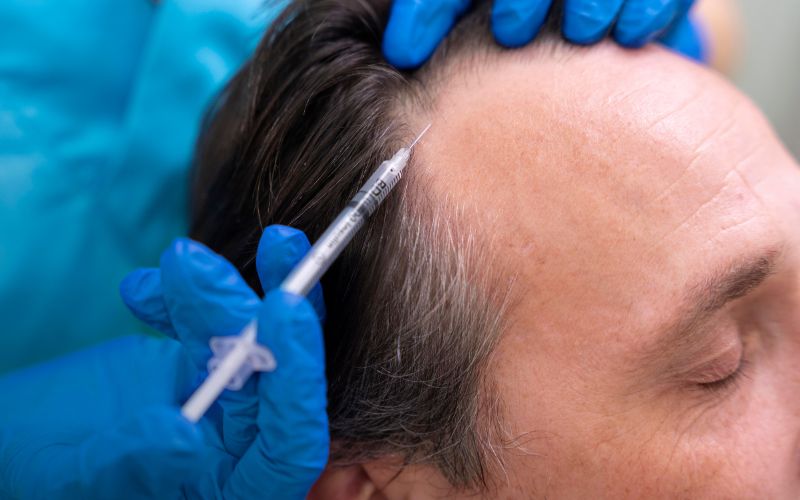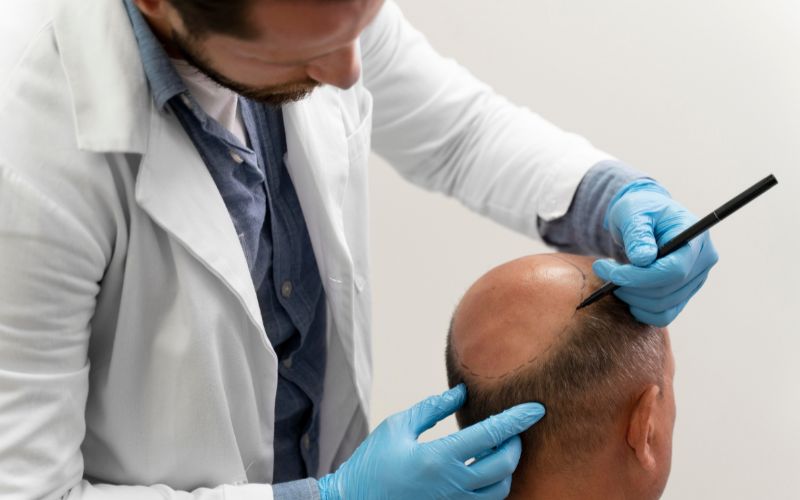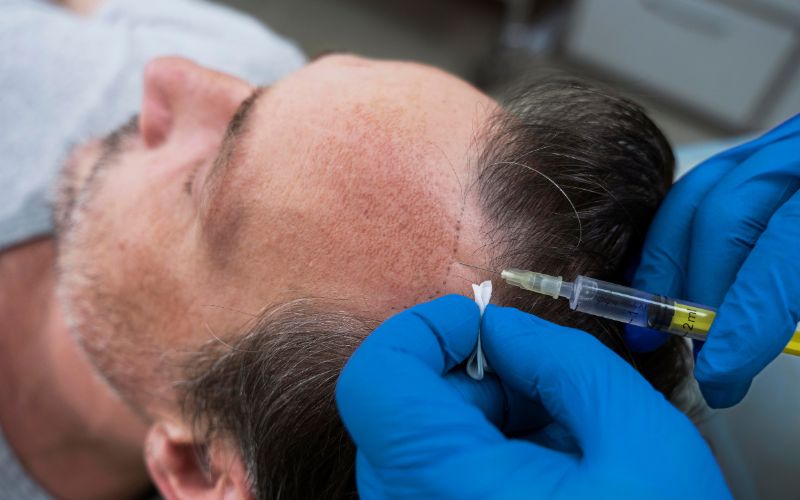Welcome to Dr. Vishal Brahmbhatt's Hair Transplant Clinic in Ahmedabad
Are you looking for a trusted and experienced hair transplant clinic in Ahmedabad? Look no further! Dr. Vishal Brahmbhatt is dedicated to providing high-quality hair transplant treatments tailored to your unique needs. With years of experience and a commitment to excellence, Dr. Brahmbhatt and his team offer state-of-the-art hair restoration solutions to help you regain your confidence and achieve natural-looking results. Our clinic is renowned as the best hair transplant clinic in Ahmedabad.
Why Choose Us?
At Dr. Vishal Brahmbhatt's clinic, we understand that hair loss can be a challenging experience. That's why we strive to create a welcoming and supportive environment where you can feel comfortable discussing your concerns. Here are some reasons why we are the best choice for hair transplant treatments in Ahmedabad:
Expertise and Experience: Dr. Vishal Brahmbhatt is a highly skilled dermatologist with extensive experience in hair restoration procedures. He stays updated with the latest advancements in the field to provide you with the best possible care at the best hair transplant clinic in Ahmedabad.
Personalized Treatment Plans: We believe that every patient is unique, and their treatment plan should reflect that. Dr. Brahmbhatt will conduct a thorough evaluation of your hair loss condition and create a customized treatment plan tailored to your specific needs and goals.
Advanced Technology: Our clinic is equipped with state-of-the-art technology and equipment to ensure precise and effective hair transplant procedures. We utilize the latest techniques, such as follicular unit transplantation (FUT) and follicular unit extraction (FUE), to deliver superior results at the best hair transplant clinic in Ahmedabad.
Natural-Looking Results: Our primary goal is to help you achieve natural-looking hair restoration results that blend seamlessly with your existing hair. Dr. Brahmbhatt's meticulous attention to detail ensures that your transplanted hair grows in the right direction and mimics the natural hairline.
Comprehensive Care: From your initial consultation to post-procedure follow-up appointments, we provide comprehensive care and support at every step of your hair transplant journey. Our team is dedicated to ensuring your comfort and satisfaction throughout the process.

Our Hair Transplant Services
Follicular Unit Transplantation (FUT): FUT, also known as the strip method, involves removing a thin strip of tissue from the donor area (usually the back or sides of the scalp) where hair is genetically resistant to balding. The strip is then dissected under a microscope into individual follicular units, which contain one to four hairs each. These follicular units are meticulously transplanted into the recipient area (balding or thinning areas) to achieve natural-looking hair growth at the best hair transplant clinic in Ahmedabad.
Follicular Unit Extraction (FUE): FUE is a minimally invasive hair transplant technique that involves harvesting individual follicular units directly from the donor area using a specialized punch tool. Unlike FUT, there is no need for a linear incision, resulting in minimal scarring and faster recovery. The harvested follicular units are then transplanted into the recipient area, following the natural hair growth pattern for optimal results.
Platelet-Rich Plasma (PRP) Therapy: PRP therapy is a non-surgical treatment that utilizes the patient's own blood to stimulate hair growth. A small sample of blood is drawn from the patient and centrifuged to separate the platelet-rich plasma from other blood components. The concentrated PRP, rich in growth factors, is then injected into the scalp to promote hair follicle regeneration, improve hair density, and prolong the hair growth cycle.
Scalp Micro-pigmentation (SMP):
SMP is a cosmetic tattooing procedure that involves depositing pigments into the scalp to simulate the appearance of hair follicles. This technique is ideal for individuals with extensive hair loss or those who prefer a short, cropped hairstyle. SMP can create the illusion of a fuller head of hair, camouflage scars from previous hair transplant surgeries, and enhance the overall aesthetic of the scalp.
Eyebrow and Beard Transplants: Eyebrow and beard transplants involve harvesting hair follicles from the donor area (typically the back of the scalp) and transplanting them into the eyebrows or beard area. This procedure is suitable for individuals with sparse or patchy eyebrows or beard growth, helping them achieve thicker and more defined brows or facial hair. The transplanted hair follicles grow naturally and can be groomed and styled like natural eyebrows or beard hair.
Pre-Operative Considerations
Patient Eligibility Criteria
Age: Ideal candidates are typically adults over the age of 25 as younger patients might still be experiencing active hair loss.
Health Status: Patients should be in good overall health without any conditions that could complicate surgery or healing (e.g., uncontrolled diabetes, blood clotting disorders).
Hair
Hair Loss Pattern: Candidates with well-defined patterns of baldness (such as male pattern baldness) are ideal. Diffuse hair loss might not yield optimal results.
Realistic Expectations: Patients must understand the limitations of the procedure and have realistic expectations about the results.
Pre-Transplant Consultation
Consideration
Medications: Avoid blood thinners, certain supplements, and medications as advised by the surgeon.
Smoking and Alcohol: Refrain from smoking and alcohol consumption at least a week before surgery.
Hair and Scalp Preparation: Instructions on washing hair with specific shampoos or solutions.
Logistics: Arrangements for post-surgery transport and care, as patients might not be able to drive immediately after the procedure.
Recovery and Healing
Typical Recovery Timeline
Immediate Post-Op (First Few Days): Mild swelling, redness, and discomfort around the treated areas. Small scabs form around the transplanted hair grafts.
First Week: Scabs and crusts begin to fall off. Patients might experience itching.
2-4 Weeks: Shedding phase where transplanted hairs fall out, making way for new growth.
1-3 Months: New hair starts to grow. It may be thin and fine initially.
6-12 Months: Significant hair growth, with thicker and denser hair.

Swelling and Redness: Use prescribed medications and cold compresses.
Itching: Avoid scratching. Use moisturizers or prescribed ointments.
Pain and Discomfort: Manage with prescribed pain relievers.
Pain and Discomfort: Manage with prescribed pain relievers.
Shedding: Normal phase called "shock loss" where transplanted hairs fall out to make way for new growth.
Long-Term Care and Maintenance
Follow-Up Visits: Regular check-ins with the surgeon to monitor progress.
Scalp Care: Gentle washing and care routines as advised.
Medications: Use of topical treatments like Minoxidil or oral medications like Finasteride if prescribed.
Healthy Lifestyle: Balanced diet, hydration, and avoidance of smoking to promote healthy hair growth.
Results and Expectations
Timeline for Hair Growth
1-3 Months: Initial new hair growth begins.
6 Months: Noticeable improvement in hair density.
12-18 Months: Final results, with fully matured hair growth.
Realistic Expectations
Density and Coverage: Depends on donor hair quality and individual response. Complete coverage might not be possible in all cases.
Hair Texture and Growth Pattern: New hair might initially appear different in texture but will gradually blend with natural hair.
Before and After Comparisons
Photos: Surgeons often provide before and after photos of previous patients to illustrate potential results.
Patient Testimonials: Hearing about other patients' experiences can provide insight into what to expect.
Rare but Serious Complications
Nerve Damage: Rare, but can lead to numbness or changes in scalp sensation.
Graft Failure: Some transplanted grafts might not take, leading to less optimal results.
Excessive Bleeding: Rare but possible during or after the procedure.
How to Minimize Risks
Choosing a Qualified Surgeon: Ensuring the surgeon is experienced and certified. Following Pre and Post-Operative Instructions: Adhering strictly to the surgeon’s advice.
Proper Aftercare: Keeping the scalp clean, avoiding direct sunlight, and following prescribed medication regimens.
Common Avoidances: Blood thinners, aspirin, anti-inflammatory drugs, and certain herbal supplements.
Frequently Asked Questions (FAQs)
A hair transplant is a surgical procedure designed to restore hair by moving hair follicles from one part of the body, typically the back or sides of the scalp (donor area), to a bald or thinning area (recipient area). There are two main methods: Follicular Unit Transplantation (FUT) and Follicular Unit Extraction (FUE). In FUT, a strip of scalp is removed and dissected into individual follicular units, while in FUE, individual follicles are extracted directly from the scalp and transplanted. The transplanted hair follicles continue to grow naturally in their new location.
A hair transplant is a surgical procedure designed to restore hair by moving hair follicles from one part of the body, typically the back or sides of the scalp (donor area), to a bald or thinning area (recipient area). There are two main methods: Follicular Unit Transplantation (FUT) and Follicular Unit Extraction (FUE). In FUT, a strip of scalp is removed and dissected into individual follicular units, while in FUE, individual follicles are extracted directly from the scalp and transplanted. The transplanted hair follicles continue to grow naturally in their new location.
A: As with any surgical procedure, hair transplants carry some risks and potential side effects. These can include infection, scarring, temporary shedding of transplanted hair (known as shock loss), and minor swelling or discomfort in the treated area. Choosing a skilled and experienced surgeon like Dr. Vishal Brahmbhatt minimizes these risks.
A: Like any surgical procedure, hair transplants come with some risks and potential side effects. Common side effects include swelling, bruising, and temporary scabbing in the donor and recipient areas. Some patients may experience itching, numbness, or temporary hair shedding known as "shock loss." Rare but more serious risks include infection, scarring, and unnatural-looking hair growth if the procedure is not performed properly. Choosing an experienced and reputable surgeon can minimize these risks and ensure a successful outcome.
Contact Information
For more information or to schedule a consultation, visit KJ Aesthetics Hair Treatments or contact Dr. Vishal Brahmbhatt’s clinic directly.
Schedule Your Consultation Today
If you're ready to take the first step towards restoring your hair and confidence, we invite you to schedule a consultation with Dr. Vishal Brahmbhatt at the best hair transplant clinic in Ahmedabad. During your consultation, Dr. Brahmbhatt will assess your hair loss condition, discuss your treatment options, and answer any questions you may have. Contact us today to book your appointment and embark on your journey to a fuller, thicker head of hair!
Welcome to Dr. Vishal Brahmbhatt's Hair Transplant Clinic in Ahmedabad

Are you looking for a trusted and experienced hair transplant clinic in Ahmedabad? Look no further! Dr. Vishal Brahmbhatt is dedicated to providing high-quality hair transplant treatments tailored to your unique needs. With years of experience and a commitment to excellence, Dr. Brahmbhatt and his team offer state-of-the-art hair restoration solutions to help you regain your confidence and achieve natural-looking results. Our clinic is renowned as the best hair transplant clinic in Ahmedabad.
Why Choose Us?
At Dr. Vishal Brahmbhatt's clinic, we understand that hair loss can be a challenging experience. That's why we strive to create a welcoming and supportive environment where you can feel comfortable discussing your concerns. Here are some reasons why we are the best choice for hair transplant treatments in Ahmedabad:
Expertise and Experience: Dr. Vishal Brahmbhatt is a highly skilled dermatologist with extensive experience in hair restoration procedures. He stays updated with the latest advancements in the field to provide you with the best possible care at the best hair transplant clinic in Ahmedabad.
Personalized Treatment Plans: We believe that every patient is unique, and their treatment plan should reflect that. Dr. Brahmbhatt will conduct a thorough evaluation of your hair loss condition and create a customized treatment plan tailored to your specific needs and goals.
Advanced Technology: Our clinic is equipped with state-of-the-art technology and equipment to ensure precise and effective hair transplant procedures. We utilize the latest techniques, such as follicular unit transplantation (FUT) and follicular unit extraction (FUE), to deliver superior results at the best hair transplant clinic in Ahmedabad.
Natural-Looking Results: Our primary goal is to help you achieve natural-looking hair restoration results that blend seamlessly with your existing hair. Dr. Brahmbhatt's meticulous attention to detail ensures that your transplanted hair grows in the right direction and mimics the natural hairline.
Comprehensive Care: From your initial consultation to post-procedure follow-up appointments, we provide comprehensive care and support at every step of your hair transplant journey. Our team is dedicated to ensuring your comfort and satisfaction throughout the process.

Our Hair Transplant Services
Follicular Unit Transplantation (FUT): FUT, also known as the strip method, involves removing a thin strip of tissue from the donor area (usually the back or sides of the scalp) where hair is genetically resistant to balding. The strip is then dissected under a microscope into individual follicular units, which contain one to four hairs each. These follicular units are meticulously transplanted into the recipient area (balding or thinning areas) to achieve natural-looking hair growth at the best hair transplant clinic in Ahmedabad.
Follicular Unit Extraction (FUE): FUE is a minimally invasive hair transplant technique that involves harvesting individual follicular units directly from the donor area using a specialized punch tool. Unlike FUT, there is no need for a linear incision, resulting in minimal scarring and faster recovery. The harvested follicular units are then transplanted into the recipient area, following the natural hair growth pattern for optimal results.
Platelet-Rich Plasma (PRP) Therapy: PRP therapy is a non-surgical treatment that utilizes the patient's own blood to stimulate hair growth. A small sample of blood is drawn from the patient and centrifuged to separate the platelet-rich plasma from other blood components. The concentrated PRP, rich in growth factors, is then injected into the scalp to promote hair follicle regeneration, improve hair density, and prolong the hair growth cycle.
Scalp Micro-pigmentation (SMP):
SMP is a cosmetic tattooing procedure that involves depositing pigments into the scalp to simulate the appearance of hair follicles. This technique is ideal for individuals with extensive hair loss or those who prefer a short, cropped hairstyle. SMP can create the illusion of a fuller head of hair, camouflage scars from previous hair transplant surgeries, and enhance the overall aesthetic of the scalp.
Eyebrow and Beard Transplants: Eyebrow and beard transplants involve harvesting hair follicles from the donor area (typically the back of the scalp) and transplanting them into the eyebrows or beard area. This procedure is suitable for individuals with sparse or patchy eyebrows or beard growth, helping them achieve thicker and more defined brows or facial hair. The transplanted hair follicles grow naturally and can be groomed and styled like natural eyebrows or beard hair.
Pre-Operative Considerations
Patient Eligibility Criteria
Age: Ideal candidates are typically adults over the age of 25 as younger patients might still be experiencing active hair loss.
Health Status: Patients should be in good overall health without any conditions that could complicate surgery or healing (e.g., uncontrolled diabetes, blood clotting disorders).
Hair
Hair Loss Pattern: Candidates with well-defined patterns of baldness (such as male pattern baldness) are ideal. Diffuse hair loss might not yield optimal results.
Realistic Expectations: Patients must understand the limitations of the procedure and have realistic expectations about the results.
Pre-Transplant Consultation
Consideration
Medications: Avoid blood thinners, certain supplements, and medications as advised by the surgeon.
Smoking and Alcohol: Refrain from smoking and alcohol consumption at least a week before surgery.
Hair and Scalp Preparation: Instructions on washing hair with specific shampoos or solutions.
Logistics: Arrangements for post-surgery transport and care, as patients might not be able to drive immediately after the procedure.
Recovery and Healing
Typical Recovery Timeline
Immediate Post-Op (First Few Days): Mild swelling, redness, and discomfort around the treated areas. Small scabs form around the transplanted hair grafts.
First Week: Scabs and crusts begin to fall off. Patients might experience itching.
2-4 Weeks: Shedding phase where transplanted hairs fall out, making way for new growth.
1-3 Months: New hair starts to grow. It may be thin and fine initially.
6-12 Months: Significant hair growth, with thicker and denser hair.

Swelling and Redness: Use prescribed medications and cold compresses.
Itching: Avoid scratching. Use moisturizers or prescribed ointments.
Pain and Discomfort: Manage with prescribed pain relievers.
Pain and Discomfort: Manage with prescribed pain relievers.
Shedding: Normal phase called "shock loss" where transplanted hairs fall out to make way for new growth.
Long-Term Care and Maintenance
Follow-Up Visits: Regular check-ins with the surgeon to monitor progress.
Scalp Care: Gentle washing and care routines as advised.
Medications: Use of topical treatments like Minoxidil or oral medications like Finasteride if prescribed.
Healthy Lifestyle: Balanced diet, hydration, and avoidance of smoking to promote healthy hair growth.
Results and Expectations
Timeline for Hair Growth
1-3 Months: Initial new hair growth begins.
6 Months: Noticeable improvement in hair density.
12-18 Months: Final results, with fully matured hair growth.
Realistic Expectations
Density and Coverage: Depends on donor hair quality and individual response. Complete coverage might not be possible in all cases.
Hair Texture and Growth Pattern: New hair might initially appear different in texture but will gradually blend with natural hair.
Before and After Comparisons
Photos: Surgeons often provide before and after photos of previous patients to illustrate potential results.
Patient Testimonials: Hearing about other patients' experiences can provide insight into what to expect.
Rare but Serious Complications
Nerve Damage: Rare, but can lead to numbness or changes in scalp sensation.
Graft Failure: Some transplanted grafts might not take, leading to less optimal results.
Excessive Bleeding: Rare but possible during or after the procedure.
How to Minimize Risks
Choosing a Qualified Surgeon: Ensuring the surgeon is experienced and certified. Following Pre and Post-Operative Instructions: Adhering strictly to the surgeon’s advice.
Proper Aftercare: Keeping the scalp clean, avoiding direct sunlight, and following prescribed medication regimens.
Common Avoidances: Blood thinners, aspirin, anti-inflammatory drugs, and certain herbal supplements.
Frequently Asked Questions (FAQs)
A hair transplant is a surgical procedure designed to restore hair by moving hair follicles from one part of the body, typically the back or sides of the scalp (donor area), to a bald or thinning area (recipient area). There are two main methods: Follicular Unit Transplantation (FUT) and Follicular Unit Extraction (FUE). In FUT, a strip of scalp is removed and dissected into individual follicular units, while in FUE, individual follicles are extracted directly from the scalp and transplanted. The transplanted hair follicles continue to grow naturally in their new location.
A hair transplant is a surgical procedure designed to restore hair by moving hair follicles from one part of the body, typically the back or sides of the scalp (donor area), to a bald or thinning area (recipient area). There are two main methods: Follicular Unit Transplantation (FUT) and Follicular Unit Extraction (FUE). In FUT, a strip of scalp is removed and dissected into individual follicular units, while in FUE, individual follicles are extracted directly from the scalp and transplanted. The transplanted hair follicles continue to grow naturally in their new location.
A: As with any surgical procedure, hair transplants carry some risks and potential side effects. These can include infection, scarring, temporary shedding of transplanted hair (known as shock loss), and minor swelling or discomfort in the treated area. Choosing a skilled and experienced surgeon like Dr. Vishal Brahmbhatt minimizes these risks.
A: Like any surgical procedure, hair transplants come with some risks and potential side effects. Common side effects include swelling, bruising, and temporary scabbing in the donor and recipient areas. Some patients may experience itching, numbness, or temporary hair shedding known as "shock loss." Rare but more serious risks include infection, scarring, and unnatural-looking hair growth if the procedure is not performed properly. Choosing an experienced and reputable surgeon can minimize these risks and ensure a successful outcome.
Contact Information
For more information or to schedule a consultation, visit KJ Aesthetics Hair Treatments or contact Dr. Vishal Brahmbhatt’s clinic directly.
Schedule Your Consultation Today
If you're ready to take the first step towards restoring your hair and confidence, we invite you to schedule a consultation with Dr. Vishal Brahmbhatt at the best hair transplant clinic in Ahmedabad. During your consultation, Dr. Brahmbhatt will assess your hair loss condition, discuss your treatment options, and answer any questions you may have. Contact us today to book your appointment and embark on your journey to a fuller, thicker head of hair!
